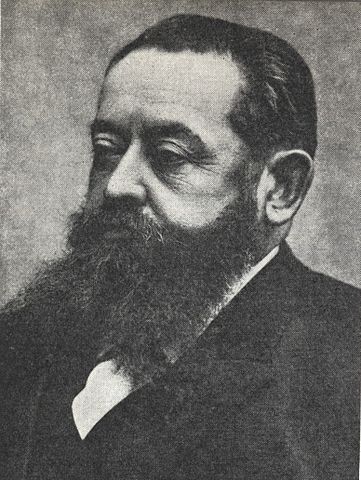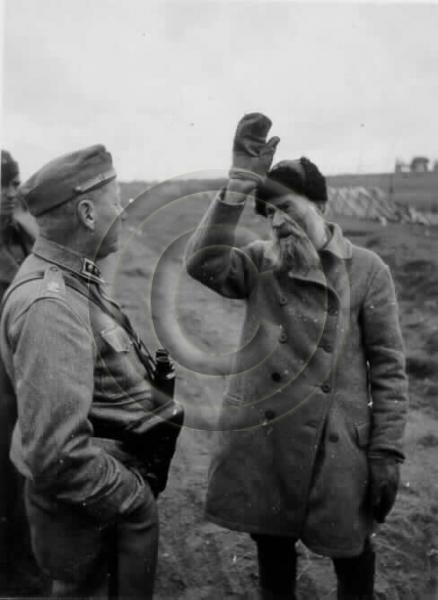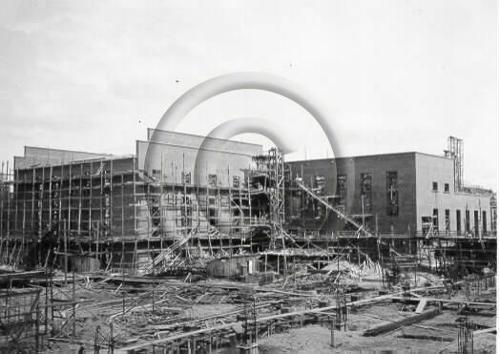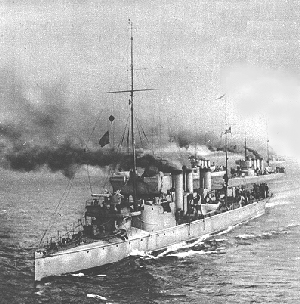Finnish Nationalism was a Key to Economic Success following independence. Although the new economic policy effectively protected Finnish industries, Finland could not dictate the rules in world markets. Rapid increases in exports and the standard of living created pressures to open domestic markets to foreign goods. As Finland modernized, the country became an attractive new market area for foreign investors. Large foreign enterprises were eager to procure rights to Finland’s largely untouched natural resources. Sizable German companies in particular viewed Finland as a potential buyer of high technology goods and supplier of wood products and minerals.
It is difficult to estimate how seriously foreign enterprises planned to invest in Finland. A number of variables mitigated against permitting foreign investment, among them the close and unsecured border with the Soviet Union, as well as Finland’s small population and long transportation routes. Yet, it is certain that harnessing the capacity of the Imatra Falls interested British and French electric power companies.
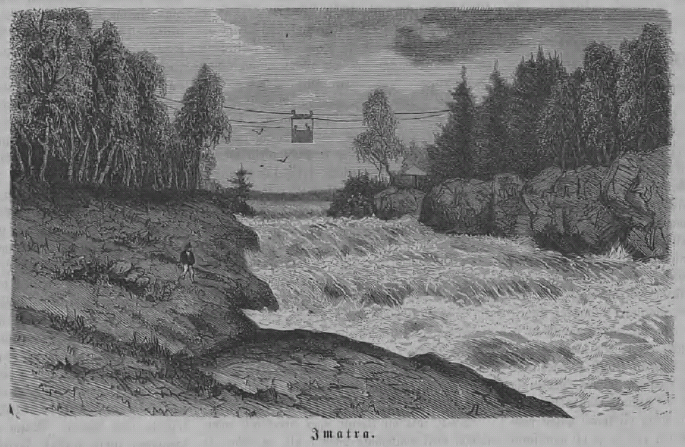
The picture above is of Imatra and appeared in the New York Sun in October 1885. It was also published in the 09/17/1883 issue of the magazine St Petersburg Novoe Vremia and described as “the Imatra rapids, Russia’s Niagara Falls “
We also know that Metallgeschellshaft tried to obtain rights to exploit the rich copper-ore deposits in Outokumpu. However, the protective barrier was strong. The only foreign companies that successfully penetrated the protective barriers were ZellstoffabrikWaldhof, which built a chemical pulp factory in Kexholm, near Lake Ladoga, and the International Nickel Corporation, which obtained rights to extract nickel ore in Petsamo.
For the Finnish government it did not matter how real or unreal foreign investment plans were. The government was determined to prevent the nation’s resources from slipping in to the hands of foreign multinational enterprises. In 1918 the state accordingly purchased two foreign owned companies, W. Gutzeit & Co. and Tornator Ltd. These transactions amounted to more than 150 million markkas, or a little over 10% of public revenue in 1918. These two companies were chosen by the Finnish government on the basis of practical considerations. British and Norwegian families owned companies had acquired more than 500,000 hectares of forest before the Finnish Senate passed laws prohibiting lumber companies from buying forested land. The state fused W. Gutzeit& Co. and Tornatori nto a new company, Enso-Gutzeit Ltd., which inherited not only the forests, but also a number of sawmills as well as pulp and paper factories. The giant state-owned company became one of the largest paper, pulp and timber manufacturers in Finland and had buyers all over the world.
The state took its next step in 1921. Parliament turned down offers from foreign companies and asked Finnish electric power and construction companies to harness the Imatra Falls. This effort was intended to demonstrate the strength and technological skill of the new nation. It was not an accident that the government chose Imatra Falls to display determination and nationalistic enthusiasm. Imatra Falls had always had cultural and social value in Finland, similar to Niagara Falls in the United States. The gigantic task of building the Imatra power station took more than ten years to complete with the total cost exceeding 250 million markka.When the power station was finished, the state founded Imatran Voima Corporation which monopolized electric power distribution in Finland.
Finally, in the early 1920s, the state purchased the rights to develop the Outokumpu copper deposit from a Norwegian-Finnish company. This transaction destroyed Metallgesellschaft’s plans to transport copper ore from the Outokumpu mine to the company’s new smelter in Hamburg. The government founded Outokumpu Mining Corporation in 1924. Soon after, the state built a production chain which linked the Outokumpu copper mines to electrolytic refineries and iron and steel works in Imatra and Pori.
These initiatives taken by the Finnish government had several important consequences. First, state owned enterprises eliminated foreign competition and concentrated the production of paper, pulp, timber and minerals in the hands of Finnish companies. Second, state owned enterprises supported private companies by investing heavily in technological and industrial infrastructure. In addition, state owned enterprises produced raw materials and semifinished goods and sold them to other industrial sectors. This decreased the need to import expensive goods from abroad. Third, state owned enterprises escalated industrialization through the use of large amounts of natural resources.
New enterprises were often built in distant locations, where private companies hesitated to invest. This was especially true in the case of the Veitsiluoto sawmill. The new sawmill was located in the northern part of Finland close to the Arctic Circle where it used large state owned forest resources. Fourth, state owned enterprises strongly affected the unification of the nation. New factories increased the consumption of wood and other raw materials in the peripheral areas of the country. This provided extra income to farmers and land-owners. State owned enterprises increased employment opportunities, which in turn decreased the rate of unemployment and thus lessened social tensions.
In spite of the rapid industrialization, in 1925 the Finnish industrial sector was still extremely specialized. Paper, pulp, timber, and iron and steel industries produced only primary products such as timber, pulp, paper, plywood, iron and copper ore.Without high technology capability, Finnish industry depended on foreign high technology companies for such goods as telephones, electric appliances, chemicals and machine-tools.
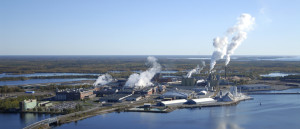
Veitsiluoto Mill in Kemi is the world’s northernmost paper producer, and number four among the biggest paper and paperboard mills in Europe.The wood processing industry first came to the island of Veitsiluoto with the opening of a sawmill here in 1922.
This dependence on foreign high technology goods and knowledge was a serious concern to the Finnish government. Although necessary, multinational enterprises represented alien interests which threatened to undermine the development of a strong national state. Once foreign investment had begun, it became difficult to prevent the incursion of foreign capital into primary production sectors. From this delicate position the government attempted to find ways to satisfy both foreign high technology enterprises and domestic companies.
To construct a safety net that would tie Finnish companies and foreign high technology enterprises neatly together, the government issued a statute in 1919 which required a foreigner to obtain a permit before establishing a business in Finland.Additionally, foreign investors could not own shares in Finnish liability companies. New laws and regulations supported these measures by stipulating that the general manager of a firm as well as a majority of members of the board of directors had to be Finnish citizens. In order to operate in Finland, foreign high technology enterprises were thus obliged to establish affiliate companies and recruit a large number of Finnish Managers, directors and engineers to operate and manage factories in Finland. This gave Finnish managers and engineers unique opportunities to obtain training and education in highly developed foreign enterprises.
The history of Finnish Chemicals provides an excellent early example of how the state successfully encouraged foreign high technology companies to support industrial development in Finland. Finnish Chemicals was founded in 1927 by three giant multinational enterprises: I G Farben, ICI and Solvay& Cie. The affiliate company, Finnish Chemicals Oy, produced bleaching chemicals (chlorine and caustic soda) for the pulp and paper industries. These chemical substances were needed to produce the white news-print which was rapidly becoming the the trademark of the Finnish paper industry on the world market.
Instead of supporting the development of domestic electro-chemical industries, the government asked I G Farben, I CI and Solvay & Cie to build an electro-chemical plant in Finland. To make the offer even more attractive, the government promised to partially finance the construction of the Aetsa plant. Because of the size and quality of the production in Aetsa, Finnish Chemicals Oy soon gained control of the rapidly growing bleaching chemical markets in Finland.As the government had expected, foreign owners equipped the Aetsa plant with the latest production technology and trained the management in England.
As this example illustrates, the government selectively allowed foreign high technology enterprises to operate in Finland. Simultaneously, legislation carefully protected the primary production sector. Formation and implementation of industrial and public policy therefore resembled in many ways the post-WW2 Japanese policy making process. Thus, Finland followed a kind of intelligent follower’s strategy by selectively allowing western influences while integrating business targets of foreign multinational enterprise with national development goals and projects.
“Patriotic Managers” and the development of Social Cohesion
In order to function effectively, the new economic policy required the support of the private business sector. In the late 19th century, a relatively strong managerial culture already existed. The first generation of business managers however represented old Swedish families who had stayed in the country after Russia captured the province of Finland from Sweden during the Napoleonic wars. Legendary entrepreneurs such as G. Serlachius, Wilhelm Rosenlew and William Ruth penetrated inhabited forest areas in order to establish modern paper, pulp and timber industries in the Russian Grand Duchy of Finland. Because of the wealth and cultural background of these men, they comprised a small Swedish elite that held political as well as economic power in Finland during the Russian regime.
The situation changed however after Finland became independent. The newly founded independent state, now ruled by the Finnish-speaking middle class, regarded the Swedish-speaking business elite as disloyal and alien. Nationalistic slogans urged the government to take action against the Swedish and return Finland to the Finns. There was, however, very little the government could do to limit the economic power of the Swedish elite. The young nation of Finland couldn’t risk loosing capital, knowledge and managerial skills during the period of transition. In order to create a balance between the Finns and Swedish-speaking business elite, the government hired top level managers for large state owned enterprises from middle-class Finnish families. This decision proved to be highly successful. Both blue and white collar workers relied on new managers who spoke the same language and shared the same ethnic heritage. These managers in turn, spread the gospel of nationalism and national unity in isolated industrial towns and villages.
V A Kotilainen, the managing director of Enso-Gutzeit, serves as a good example of this class of manager. During the civil war, Kotilainen served in White headquarters, where he established a personal friendship with top level politicians and military leaders of the White army. Soon after the war, Kajana Wood Corporation hired Kotilainen to be its executive manager. At the time, Kajana Corporation was one of the largest pulp, paper and timber corporations in the country. What was more important, however, was that the devotedly nationalistic Paloheimo family owned the corporation. Kotilainen created an even stronger nationalistic image for the company than it already had. General Rudolf Walden, the distinguished head of the United Paper Mills and a close friend of General Mannerheim, strongly encouraged the government to hire Kotilainen to be the new executive director for the state owned Enso-Gutzeit company in 1924. Walden’s trust in Kotilainen came from the time the two men spent together at the White headquarters during the Civil War.
Kotilainen managed Enso-Gutzeit from 1924 on. One of his first management acts was to ensure the image of the company became increasingly Finnish, moving the company headquarters to a new location, Enso, in the eastern part of the country. In addition, he introduced Finnish as the company’s official language and strongly rejected Swedish which had been spoken in board meetings and business offices for more than two centuries. Finally Kotilainen changed the company’s name by replacing an originally Norwegian name, W . Gutzeit & Co., with the Finnish Enso-Gutzeit, emphasizing the favored Finnish culture and ethnic heritage over the previously dominant Swedish culture.
Finnish Nationalism continually shaped the social policy of Enso-Gutzeit. It was a dream of VA. Kotilainen to organize the work and life of the company’s paper, pulp and timber factories so that blue and white collar workers and managers could live in proximity and harmony. The social policy of Enso-Gutzeit provided employees with modern medical care, primary education and vocational training free, or at minimal cost and from 1931 on actively encouraged employees at all levels to join the Suojeluskunta (the Finnish Civil Guard) or, if female, the Lotta Svard.
Additionally, the company commissioned top Finnish architects (for instance Alvar Aalto) to design houses and buildings for workers and managers. Kotilainen also hired Martti Jukola, a leading Finnish journalist and powerful national agitator, as the editor-in-chief for the company’s weekly journal, which had a strongly nationalist agenda. In this, Enso-Gutzeit set a policy and standard which was followed by all other state-owned, and many private, companies.
Limitations on Development
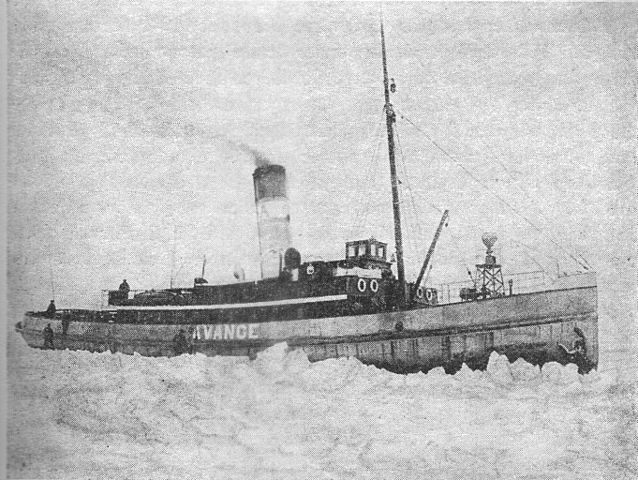
Finnish Icebreaker Apu, originally built as Avance in 1899. The Apu (“Assistance”) remained in service until 1959 and was used in the Archipelago Sea.
However, the new-found economic successes of the first half of the 1920’s could not be maximized as well as they could have been due to two factors. The first was Nature. Finnish ports were blocked by ice for the winter months and with icebreakers only available for Hanko and Turku, only these ports could be kept (mostly) open throughout the long Nordic winter. This was not optimal for Finnish forestry industries as the primary export harbors for forestry products were Viipuri (connected via the Saimaa canal to Finland’s inland lakes) and Kotka. The Ports of Oulu and Kemi, situated at the mouth of the Oulujoki and the Kemijoki respectively, were needed to ship forestry products from the large wood reserves of their hinterland, but could not be exploited at all during winter months.
The second limiting factor was a man-made one. Finnish Shipping Companies were small and had difficulty servicing export markets. Due to their small size they experienced difficulties in being accepted into the cartel system operated by the large transoceanic shipping companies. For example, it was impossible for Finnish ships to carry cargoes of coffee from South America to Europe, meaning that while they could carry freight out, it was next to impossible to find freight to carry back, making voyages uneconomic. The dependence of Finnish exporters on foreign shipping companies resulted in lost transit time and worse access to foreign markets. Finnish products were often sold without any mention of their Finnish origins, which in practice meant an inability to create lasting trade relationships.
At the same time, the established Finnish ship-building industry was experiencing a marked decline. Up until 1917, Finnish shipbuilding had been largely sustained by a combination of the Russian merchant shipping and naval markets. Post WW1, the Russian market had evaporated and the penetration of new markets was difficult as a result of the post-WW1 abundance of merchant shipping. The long-term prospects for the Finnish shipbuilding industry seemed bleak. It was at this point, in the mid-1920’s, that a number of different economic and political factors came together with effects that had long term ramifications for both Finland, and, later, for Europe.
The first factor was the occurrence, on 4 October 1925, of the worst accident suffered by Finnish defence forces in peacetime, when the old Torpedo Boat S2 sank outside Pori with the total loss of all 53 crew. The accident sparked widespread public outrage which was exploited by both naval and industrial circles. The Finnish Navy had been established in 1918 using a hodge-podge of Russian Czarist Navy ships left in Finland during the chaotic “Baltic Fleet ice cruise” which had occurred during the Finnish Civil War. The ships taken over by the Finnish Navy did not meet Finnish defence needs and were mostly obsolete while the officers and seamen of the new navy were not that skilled. This combination of causes had led to the loss of the S2. It was at this point that a new organization – Laivastoyhdistys, or the Finnish Navy League – was established by naval and industrial circles to promote the need for the construction of new ships for the Finnish Navy.
The second factor was a combination of the above-mentioned decline of the shipbuilding industry together with the difficulties being experienced by the forestry industry in exporting and the inability to penetrate markets of the small Finnish shipping companies. The third factor was political, and was largely the work of one man, Marshal Mannerheim, the leader of the Whites in the Finnish Civil War and the former Regent of Finland immediately after the Civil War. Mannerheim had retired after losing the race for the first Finnish Presidential elections, but continued to be highly influential in Finnish politics, almost despite himself, for he was not by any stretch of the imagination a politician.
Mannerheim’s concern, articulately and forcefully expressed, was that in order to maintain its continuing independence, Finland needed to ensure its Armed Forces were capable of defending itself without any reliance on foreign powers. And that defence would be against the Soviet Union, the only state that threatened the existence of Finland. That this was not a welcome message to many politicians of the Left was somewhat of an understatement. From independence until the mid-1920’s, Finland’s government had neglected the military, concentrating on social and economic reforms and almost willfully ignoring the Bolshevik Government that now ruled what had become the Union of Soviet Socialist Republics.
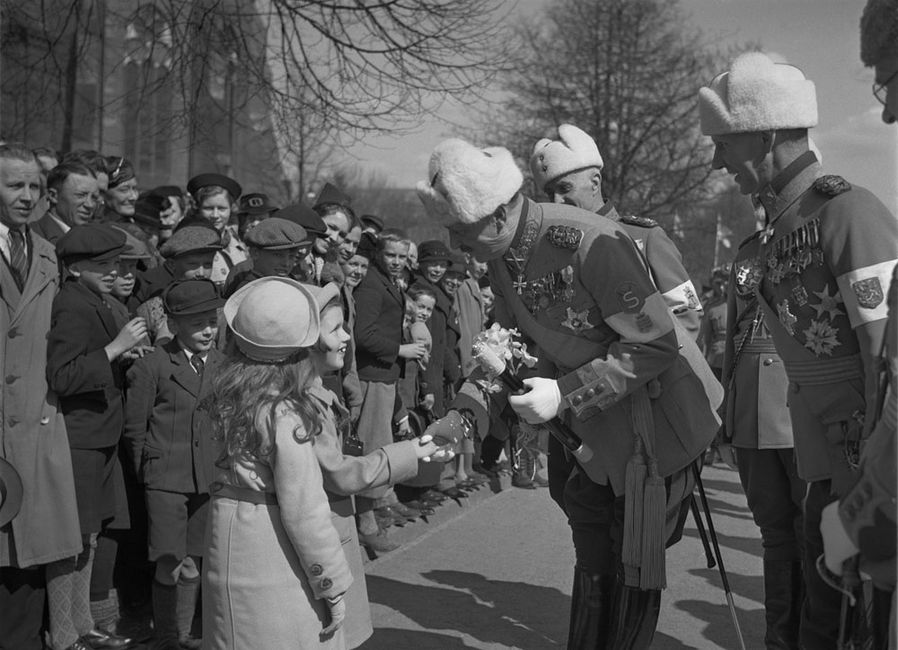
Field Marshal Mannerheim being greeted by Finnish girls at the 20th anniversary celebration of the libration of Viipuri, Finland, 1938
Finnish military equipment was either semi-obsolete or non-existent. The Air Force and Navy could not provide any credible deterrent and the Army, while sizable in numbers when the Reserves and Civil Guard were mobilized, was basically an infantry force of 9 Divisions with little in the way of modern artillery, ammunition stockpiles or even uniforms. As Mannerheim articulated it, in the event of a war with the Soviet Union, Finland would, with the exception of its border with Sweden, be geographically isolated. And relations with Sweden in the mid-1920’s were strained, largely over the Aland Islands issue. Any foreign aid would take time to arrive and would be beset by considerable logistical difficulties, not least of which would be the Soviet naval threat within the Baltic and the icing over of the Gulfs of Finland and Bothnia for a good part of the year. Mannerheim was also very much a realist with regard to both diplomatic and military assistance – it was unlikely that the League of Nations would do anything more constructive than condemn any attack, and while Finland could expect public sympathy in Europe and North America, this would be unlikely to translate into any substantive assistance.
Nor could any decisive assistance be expected from Finland’s Nordic neighbours, Sweden and Norway. Norway had a small and ill-equipped military and, politically, was unwilling to make any commitments. Sweden’s left-wing government was not a reliable defense partner and was unwilling to enter into defensive agreements with Finland, and would in all likelihood give in to Soviet pressure not to intervene in any conflict. And there was also a major disagreement with Finland over the status of the Aland Islands. Mannerheim’s position was that while it was very much evident that the only real threat to Finland was the Soviet Union, the Finnish Armed Forces were not in a position to provide an effective defence and no help could be expected from other countries if Finland was attacked.
It was this position that Mannerheim sought to correct and in this, he sought support from all sectors of Finnish society – with, as we know, surprising success, both for the Finnish economy and for the Finnish military.
 Copyright secured by Digiprove © 2013 Alternative Finland
Copyright secured by Digiprove © 2013 Alternative Finland



